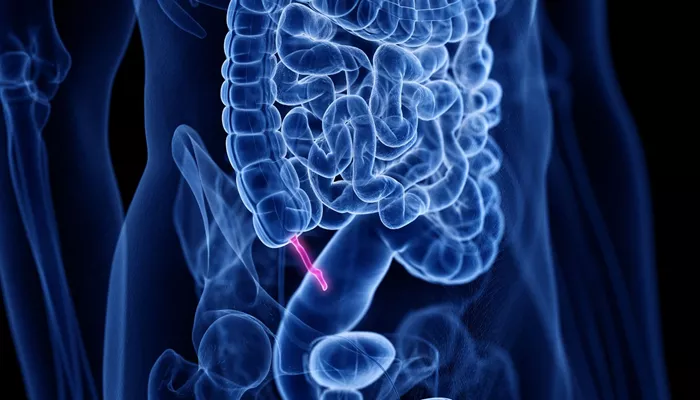Appendicitis creates a distinct pattern of discomfort that differs from ordinary stomach aches. The small pouch attached to your large intestine can cause surprisingly intense pain when inflamed or infected. Recognizing these sensations early helps people seek timely medical care before serious complications develop.
The First Warnings
Discomfort begins near the belly button. A vague, hard-to-pinpoint ache starts subtly, often mistaken for gas or mild indigestion. Many ignore this early sign, assuming it will pass.
The pain feels different from typical stomach upset. Unlike food-related discomfort that comes in waves, appendicitis pain remains constant and gradually intensifies over hours.
Loss of appetite appears early. Even favorite foods become unappealing, which is unusual compared to stomach viruses where hunger might persist.
Mild nausea may develop. Some people feel queasy but don’t actually vomit during initial stages. This nausea doesn’t relieve the abdominal discomfort like stomach bug nausea sometimes does.
The Pain’s Progression
After several hours, the ache migrates downward. It settles in the lower right abdomen, about halfway between the hip bone and belly button. This shift to a specific location is classic for appendicitis.
The character of pain becomes sharper. What began as dull discomfort transforms into a more intense, persistent ache. Coughing or sudden movements make it worse.
Tenderness develops at the new location. Light pressure hurts, and releasing the pressure often causes a sharp twinge of pain. Many instinctively draw their knees up to ease the discomfort.
Walking may become difficult. Some develop a slight limp as movement aggravates the inflamed area. Taking deep breaths can also intensify the pain.
Accompanying Symptoms
Low-grade fever often develops. Temperatures typically range between 99-101°F as the body reacts to the inflammation.
Digestive changes frequently occur. Some experience constipation, while others have diarrhea. Passing gas becomes difficult despite bloating.
Urinary symptoms sometimes appear. Frequent or painful urination may develop if the inflamed appendix irritates nearby bladder nerves.
General malaise sets in. Energy levels drop, and most people feel significantly unwell, unlike with minor stomach bugs.
How Children Experience It Differently
Young patients may struggle to describe the pain. Children often just say their stomach hurts all over rather than pointing to specific locations.
Fever tends to be higher in kids. Temperatures often spike above 102°F as children’s immune systems react strongly to the infection.
Symptoms progress more quickly. The time from first pain to severe symptoms is often shorter in children than in adults.
Behavior changes may be the first sign. Irritability, refusal to eat, or unusual quietness sometimes appear before complaints of specific pain.
When The Appendix Ruptures
There may be temporary pain relief. Some mistakenly think they’re improving when a ruptured appendix releases pressure, but this is actually dangerous.
Pain then spreads across the abdomen. Instead of remaining localized, the discomfort becomes more generalized as infection spreads.
Fever spikes higher. Temperatures often jump above 102°F as the body reacts to bacteria escaping into the abdominal cavity.
Overall condition worsens rapidly. Nausea increases, heart rate speeds up, and the person appears obviously ill compared to earlier stages.
Comparing Similar Conditions
Food poisoning causes more vomiting. While appendicitis may cause nausea, frequent vomiting suggests stomach flu instead.
Kidney stones create wave-like pain. The pain comes in intense waves rather than the steady buildup of appendicitis.
Ovarian cysts cause cyclical pain. Women may confuse appendicitis with mittelschmerz or cyst pain that follows menstrual cycles.
UTIs produce burning urination. Urinary symptoms without the characteristic abdominal pain progression suggest bladder infection.
What Makes Appendicitis Pain Unique
It steadily worsens over hours. Unlike gas pains that come and go, appendicitis discomfort intensifies continuously.
Movement aggravates it specifically. The pain increases noticeably when going over bumps in a car or walking downstairs.
No position brings complete relief. While curling up may help slightly, the ache persists regardless of how you lie or sit.
Pain precedes other symptoms. The abdominal discomfort appears before fever or nausea in most cases.
When To Seek Emergency Care
Pain lasting over four hours warrants evaluation. Any persistent, worsening abdominal pain needs medical assessment.
Inability to keep liquids down is concerning. Persistent vomiting alongside abdominal pain requires prompt attention.
High fever with abdominal pain is dangerous. Temperatures above 102°F suggest advanced infection needing treatment.
Confusion or severe weakness develops. These signs indicate possible sepsis from ruptured appendix and need immediate care.
Conclusion
Appendicitis produces a distinctive pain pattern that begins vaguely near the navel before migrating to the lower right abdomen and intensifying steadily. The constant, worsening discomfort differs from ordinary stomach aches and accompanies loss of appetite, low-grade fever, and general malaise. Recognizing this progression is crucial since delayed treatment risks life-threatening complications from rupture. While no single symptom confirms appendicitis, the combination of these feelings – especially the characteristic pain movement and persistence – should prompt immediate medical evaluation. Trusting your instincts about unusual abdominal pain can prevent dangerous delays in treatment. Modern surgical techniques make appendicitis highly treatable when caught early, allowing most people to recover completely within weeks. Paying attention to what your body is telling you makes all the difference in outcomes for this common but potentially serious condition.
Related topics:
How to Tell If Your Appendix Is Going to Burst?
How Long After Appendix Surgery Can You Have Intercourse?
What Are Signs Of A Bad Appendix?


